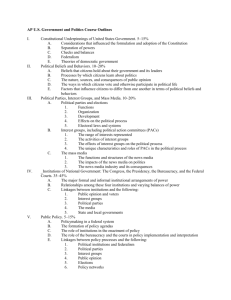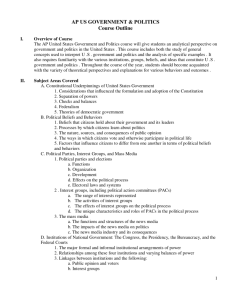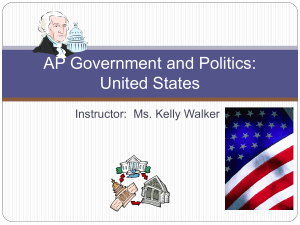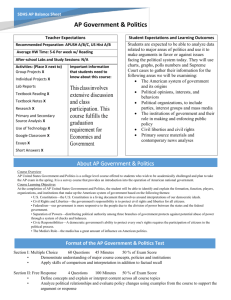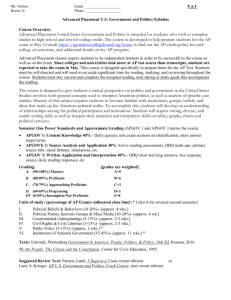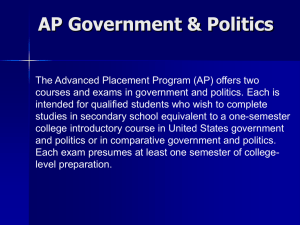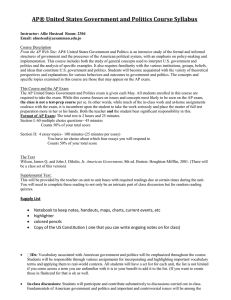The aim of the AP Government course is to provide the student with
advertisement
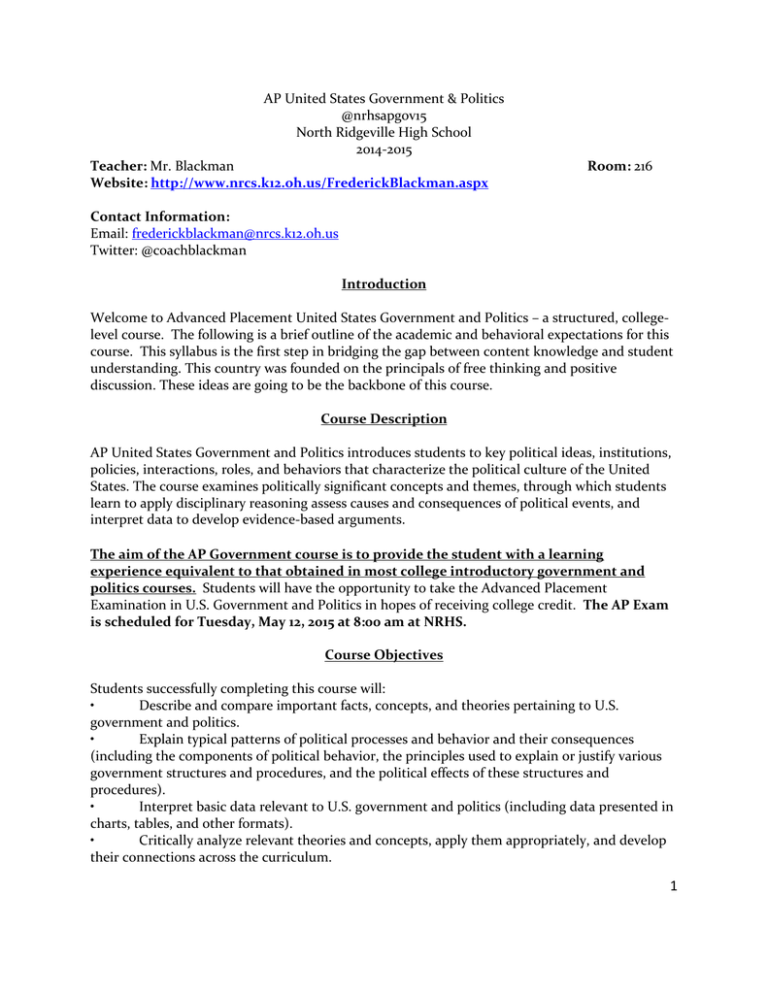
AP United States Government & Politics @nrhsapgov15 North Ridgeville High School 2014-2015 Teacher: Mr. Blackman Website: http://www.nrcs.k12.oh.us/FrederickBlackman.aspx Room: 216 Contact Information: Email: frederickblackman@nrcs.k12.oh.us Twitter: @coachblackman Introduction Welcome to Advanced Placement United States Government and Politics – a structured, collegelevel course. The following is a brief outline of the academic and behavioral expectations for this course. This syllabus is the first step in bridging the gap between content knowledge and student understanding. This country was founded on the principals of free thinking and positive discussion. These ideas are going to be the backbone of this course. Course Description AP United States Government and Politics introduces students to key political ideas, institutions, policies, interactions, roles, and behaviors that characterize the political culture of the United States. The course examines politically significant concepts and themes, through which students learn to apply disciplinary reasoning assess causes and consequences of political events, and interpret data to develop evidence-based arguments. The aim of the AP Government course is to provide the student with a learning experience equivalent to that obtained in most college introductory government and politics courses. Students will have the opportunity to take the Advanced Placement Examination in U.S. Government and Politics in hopes of receiving college credit. The AP Exam is scheduled for Tuesday, May 12, 2015 at 8:00 am at NRHS. Course Objectives Students successfully completing this course will: • Describe and compare important facts, concepts, and theories pertaining to U.S. government and politics. • Explain typical patterns of political processes and behavior and their consequences (including the components of political behavior, the principles used to explain or justify various government structures and procedures, and the political effects of these structures and procedures). • Interpret basic data relevant to U.S. government and politics (including data presented in charts, tables, and other formats). • Critically analyze relevant theories and concepts, apply them appropriately, and develop their connections across the curriculum. 1 Grading Policing Students' grades will be based upon unit exams comprised of 40 multiple-choice, AP-style questions and two FRQs (free-response questions); quizzes (announced and unannounced); and participation and course work (projects, reports, debates and oral presentations). These assessments will often feature map, chart, and graph reading skills. Grades will be based upon a point system. The following scale (Board of Education Policy) will be used to determine final grades for each quarter: Percentage Scale A = 93 – 100 A= 90 – 92 B+ = 87 – 89 B = 83 – 86 B= 80 – 82 C+ = 77 – 79 C = 73 – 76 C= 70 – 72 D+ = 67 – 69 D = 63 – 66 D= 60 – 62 F = Below 60 Quality Points A = 5.00 A= 4.67 B+ = 4.33 B = 4.00 B= 3.67 C+ = 3.33 C = 3.00 C= 2.67 D+ = 1.33 D = 1.00 D= .67 F = .00 If a student scores above the top limit for a percentage by any fraction of .5 or more, the next highest letter grade will be considered achieved (e.g., 89.5% = A-). A standards based grade is a system of reporting student proficiency in a number of specific learning goals (or standards). Rather than give students one grade on a test that assessed multiple skills, this system gives students a number of scores that represent their proficiency in each of the skills assessed. The idea is that at the end of the class a student has mastered the essential content necessary for the next level. You are focused on knowledge, not on points. On occasion standards based grades might be used. Here’s how it will be reflected on the typical scale above. Standards Based Scale 4-Advanced 3-Proficient 2-Partially Proficient 1-Inadequate Proficiency 0-Not Proficient Letter Grade Equivalent A: 3.75-4.00 A-: 3.50-3.74 B+: 3.25-3.49 B: 3.00-3.24 B-: 2.75-2.99 C+: 2.5-2.74 C: 2.00-2.49 C-: 1.75-1.99 D+: 1.50-1.74 D: 1.25-1.49 D-: 1.00-1.24 F: 0.00-0.99 2 Student Expectations 1. Respect: I treat students as attentive, responsive, and mature young adults with the ability to function in a social setting. You are expected to listen both to the teacher and to other students at all times. Do not talk while others are talking. Treat all school property with respect. If it is not yours, do not touch it. 2. Effort: Give your best effort on each and every assignment and activity. Conduct yourself in a manner which promotes learning. Follow directions the first time. 3. Participate: Attempt activities and be involved in class discussions to the best of your ability. Do nothing that interferes with class: no sleeping, no grooming, etc. Putting your head down, not paying attention, or doing work for another class is unacceptable behavior. 4. Preparation: Be prepared each day. This means you are to sit down, ready to work when the bell rings. It also means that you are to bring all materials (pen/pencil, textbook, notebook, etc) to class. Not having the necessary materials will result in a detention. 5. Tardiness: Be on time for class everyday – this means that you are in the room before the door shuts. If you are late, you must have a pass from a teacher or accept a detention for tardies two and three. On the fourth tardy and all subsequent tardies, you will be referred to the principal’s office. 6. Late Work: Late work will always be accepted after the original due date, but with a points deductions. 7. Absences: It is up to the student to recover any work missed while absent. The student will have the number of days missed to turn in assignment with no penalty. 8. Sustained Silent Reading (SSR): Every Tuesday for the first 15 minutes of class will be SSR. You must bring a school appropriate book, newspaper, magazine with you to class on Tuesdays. You will NOT be permitted to put your head down/sleep, have a pen/pencil in your hand, or sit and stare. EVERYONE is expected to be reading each Tuesday Consequences for Inappropriate Actions 1. Verbal Warning 2. Discussion with teacher after class 3. Detention (possible call home) 4. Office Referral 3 Summary of Topics I. Constitutional Underpinnings of United States Government Percentage goal for AP Objective Exam: 5-15% A. Considerations that influenced the formulation and adoption of the Constitution B. Separation of powers C. Checks and Balances D. Federalism E. Theories of democratic government II. Political Beliefs and Behaviors of Individuals/Elections Percentage goal for AP Objective Exam: 10-20% A. Beliefs that citizens hold about their government and its leaders B. Processes by which citizens learn about politics (political socialization) C. The nature, sources, and consequences of public opinion D. The ways in which citizens vote and otherwise participate in political life E. Factors influencing citizens to differ from one another in terms of political beliefs & behaviors III. Political parties, Interest Groups, and the Mass Media: Mechanisms that facilitate the communication of interests and preferences of like-minded citizens Percentage goal for AP Objective Exam: 10-20% A. Political parties and elections 1. Functions/Goals 2. Organization 3. Historical Development 4. Effects on the political process 5. Electoral laws and systems B. Interest groups, including political action committees (PACs) 1. The range of interests that are or are not represented 2. The activities of interest groups and PACs 3. The effects of interest groups on the political process 4. The unique characteristics and roles of PACs in the political process C. The mass media 1. The functions and structures of the news media 2. The impacts of the news media on politics 3. The news media industry and its consequences IV. Institutions of the National Government: Legislative Branch (Congress), Executive Branch (The President), Judicial Branch (The Federal Courts) and the Bureaucracy Percentage goal for AP Objective Exam: 35-45% A. The major formal and informal institutional arrangements of power B. Relationships among these four institutional arrangements of power C. Linkages between institutions and the following: 1. Public opinion and voters 4 2. 3. 4. 5. Interest Groups Political Parties The media State and local governments V. Public Policy Percentage goal for AP Objective Exam: 5-10% A. Policy making in a federal system B. The formation of policy agendas C. The role of institutions in the enactment, implementation, and interpretation of policy, especially the bureaucracy D. Linkages between policy processes and the following: 1. Political institutions and the concept of federalism 2. Political parties 3. Interest groups 4. Public opinion 5. Elections 6. Policy Networks VI. Civil Rights and Civil Liberties Percentage goal for AP Objective Exam: 5-15% A. The development of civil liberties and civil rights by judicial interpretation B. Knowledge of substantive rights and liberties C. The impact of the 14th Amendment on the constitutional development of rights and liberties Unit 1: Constitutional Underpinnings of the United States Government Chapters 1, 2, 3, 4 Estimated Time: 8/25-9/19 Percentage goal for AP Exam 5-15%: What is the purpose of government? What was the founders’ view of the purpose of government and the role of the citizen in the American Republic? Are these views still relevant? The concept of checks and balances was a novel idea in the 18th Century – why? How does Madison’s concept of checks and balances challenge popular understanding of Montesquieu’s theory of separation of powers? Define and explain the following: democratic theory, republicanism, pluralist theory, majoritarianism, and the elitist theory. Unit 2: Political Beliefs and Behaviors/Elections Chapters 1, 2, 9, 12 Estimated Time: 9/22-10/24 Percentage goal for Exam 10-20%: How are we imprinted with our political beliefs? What are the sources of public opinion? What is political culture and what is the “American political culture”? What is the political spectrum? How do political beliefs define who we are as 5 citizens? What does it mean to be a citizen? What is the role of a citizen in a modern civil society? Who votes and why? Who cannot vote and why? What is the relationship between individual rights and the needs of the larger community? Is American Democracy viable in today’s world? Unit 3: Institutions of National Government: The Congress, the Presidency, the Bureaucracy, the Federal Courts, and Supreme Court Cases Chapters 4, 5, 6, 7, 8, 13, 14 Estimated Time: 10/27-1/15 Percentage goal for Exam 35-45%: How is Congress organized? What are the qualifications to become a member? How does Congress reflect the interests of the nation? Compare and contrast the operations of the House and Senate. How is the executive branch organized? What are the qualifications to become President? What are the formal and informal powers of the president? How does the president use these powers to influence policy? Is the president too powerful or not powerful enough vis-à-vis the legislative and judicial branches? What role do the courts play in implementing policy? Doe the courts legislate from the bench via their interpretation of the Constitution? What is the constitutional role of the courts regarding public policy? How has this evolved through our history? What is the evolving relationship between the courts and civil rights? What are the specific issues the bureaucracy addresses in public policy making? Define and evaluate “Iron Triangles”. How do they influence public policy implementation? Who controls the bureaucracy? Are there advantages to having a larger, more permanent bureaucracy? Unit 4: Political Parties, Interest Groups, and Mass Media Chapters 9, 12 Estimated Time: 1/20-3/13 Percentage goal for Exam 10-20 %: What is the difference between Republicans and Democrats? What about third parties? Are they viable? Are they effective? What are the roles of political parties and interest groups? Do they hurt or help our political system and why? What influences do these groups have on our government? How are candidates selected to run for office? What are the roles of party organizations and PACs in the electoral process? What is hard and soft monies? What rules are in place to protect the campaign system? What new rules need to be instituted? Does the system need to be reformed? What roles do the media play in elections and shaping public opinion? Unit 5: Public Policy Chapters: 5, 6, 7, 9, 15 Estimated Time: 3/16-4/17 Percentage goal for Exam 5-15%: Who sets policy and agendas? How does federalism affect public policy? How is the Federal Reserved organized and how does it function within our 6 economy? What decisions does this group make that affects economic policy? How is the federal budget made? Compare and contrast monetary and fiscal policy. What is a global economy? How does it affect the U.S. economy? What are subsidies and entitlements? What is the proper role of the government in issues such as education, health care, welfare, crime, and retirement? What should the U.S. role in the world be? What is our relationship with the United Nations? Unit 6: Civil Rights and Civil Liberties Chapters: 8, 10, 11, 13 Estimated Time: 4/20-5/29 Percentage goal for Exam 5-15%: What constitutes freedom of speech? How does the national Bill of Rights apply to the states? What forms of speech are protected and which are not? How is the 1st Amendment affected in times of crisis? What are the limits of free exercise? What is the establishment clause? What is equal protection under the law? What is due process (procedural and substantive)? How have laws like the Civil Rights Act of 1964 and the Voting Rights Act of 1965 impacted our society? These date ranges take into account scheduled days of class only, and do not factor in for calamity days. In the event of adjustments an amended schedule will be provided. Participation The participation grade in the course will be made up of two ongoing assignments. The first assignment is a current event portfolio. The portfolio will be made up of eight (8) news articles dealing with this course, as well as presenting one of your articles three times a quarter on Current Events Friday. At the end of each quarter I will collect the portfolios. The other half of the participation grade will come from Twitter Tuesday. On Twitter Tuesday we will use twitter as a discussion board for the class. Each student is required to participate. AP Exam The AP United States Government and Politics Exam has two sections. In the first section, students have 45 minutes to answer 60 multiple-choice questions. In the second section, students have 100 minutes to complete four free-response questions. Each section counts for half of the overall score. Throughout the year we will be working on the skills necessary to successfully take the exam. Technology As a class we will use a wide range of technology to better enhance or learning experience. To better our use of technology, my classroom is a BYOD environment. BYOD stands for bring your own device. Devices such as Smartphone’s and tablets will be used regularly. If you are bringing a 7 Smartphone to class please remember to turn ringer off. Regular school policies are to be followed upon exiting room 216. In the event that the class receives a class set of tablets, BYOD will be no longer in effect. Disclaimer: This course syllabus is not meant to be all encompassing. As the course progresses, there may be need for modifications to the course content, assignments, expectations, or procedures. Students will be informed of any changes. 8
